Are you as fed up as I am with being told to reduce your carbon ‘footprint’? Angry that you won’t be able to buy a new petrol or diesel car after 2030 or 2035 (take your pick)? Annoyed by being told you must have an expensive but inadequate heat pump installed in your home instead of an efficient gas or oil boiler and pissed off with being told, into the bargain, that you can’t have a wood-burning stove either? Irritated by being told that you should eat less meat because cattle and sheep produce carbon dioxide and methane (what about pigs?) All of this is in pursuit of the unattainable dream of Net Zero carbon dioxide (CO2) which the climate zealots claim the people of the earth must achieve to limit global warming to +1.5℃ this century. The ‘warmist’ cult insists that our collective CO2 output is the reason the Earth is getting warmer. It hasn’t got one fraction of a degree warmer for nigh-on twenty years, but we’ll leave that aside for another day.
Carbon dioxide has been painted as the ‘bad guy’ in climate change. It absorbs and retains solar energy, the activists say. The more carbon dioxide in the atmosphere, the warmer the planet will be until it reaches a tipping point when we will be victims of a runaway heating which we will not be able to stop. The icecaps will melt, the sea-level will rise, crops yields will fall leading to a world-wide food shortage and mass migrations will be triggered as desperate people strive to survive by fleeing from the hot and flooded regions.
They even call it carbon, dropping the dioxide bit, because we all know carbon is black and dirty (think coal), so it’s used to create an idea that carbon dioxide is dirty. When he was US President, Barak Obama even managed to have it declared to be a pollutant. The latest US National Climate Assessment published by the US National Oceanic and Atmospheric Administration (NOAA) has this to say right at the start:
“The US has made progress in reducing heat trapping carbon pollution, but extreme weather caused by climate change is harming U.S. residents in every region”.
So, there it is, CO2 is an atmospheric pollutant. This is nonsense, of course, and here’s why. Let’s start by considering what CO2 is: It is a trace natural gas, odourless and tasteless, which is essential for all life on Earth. As far as we are concerned, it is the most important molecule on the planet. No CO2, no life on Earth. When asked, most people have no idea how much CO2 is in the atmosphere. Guesses range from about 5% to as wild as 50% in the case of some petrified climate-alarm victims. In fact, it is a little over 0.04% of the atmosphere (415 parts per million to be precise). There once was rather a lot of CO2 in the planet’s atmosphere but that was a very long time ago. Hundreds of millions of years.
According to the celebrated Australian geologist Professor Ian Plimer, the Earth has had three different atmospheres. The first one which was created shortly after the planet was formed 4,640 million years ago (mya) was mostly ammonia with some hydrogen and helium and a little CO2. The first water appeared shortly thereafter in geological terms, about 4,400 mya in the Hadean Eon. Then CO2 began to increase markedly due to off-gassing (volcanic activity) to create the second atmosphere, rich in CO2, more than 100 times as much CO2 as there is around us today. There was no runaway global warming during this period. It was during this time, in the Archean Eon, that photosynthesis began about 3,500 mya. By 2,200 mya in the Proterozoic Eon there was atmospheric oxygen and the Earth’s third, and so far, final atmosphere was beginning to take shape.
Geologists know that the Earth has undergone six major ice ages, three of which occurred before the Cambrian explosion of multi-cellular life 570 mya: the Pongola (2800 mya), the Huronian (2200 mya) and the Cryogenian (about 700 mya). All three occurred when the atmosphere was CO2 rich. That alone proves that there can be no link between increased amounts of CO2 and rising temperatures.
We’ll skip the next two ice ages and fast forward to the Eocene period when the earth had warmed to a climatic optimum about 49 mya when it was as much as 10℃ warmer on average than it is today with a smaller difference in temperature between the equator and the poles. There was virtually no ice, and the sea-level was about 150 metres higher than at present.
Following the Eocene climatic optimum there was a gradual descent into an ‘icehouse’ climate at the Eocene–Oligocene transition 34 mya. During this decrease, ice began to reappear at the poles, and at the Eocene–Oligocene transition the Antarctic ice sheet began to expand rapidly as the planet entered cooler periods. The Quaternary/ Pleistocene Ice Age started 2.58 mya and has proceeded with a series of glacial and warmer inter-glacial periods, about 44 in all. Over the last 800,000 years there have been nine complete glacial cycles from maximum glaciation to warm inter-glacial peak and back again.
People are fond of the expression “since the last ice age” but the truth is that the Pleistocene Ice Age is still in progress as evidenced by the presence of polar ice, montane glaciation and the Greenland ice sheet. The warm inter-glacial period we are in, the Holocene inter-glacial, started about 11,700 years ago. Given that interglacial periods have lasted from 10,000 to 15,000 years we are due for a descent into another glaciation. There is no reason to suppose this will not happen sometime in the next 3,000 years. Now, that’s climate change.
In the course of the many cycles of the Pleistocene Ice Age the level of carbon dioxide drifted up and down between 180 and 280 parts per million (ppm) of the atmosphere (0.018-0.028%) but never went above 300 parts per million (0.03%). The lower figure, 180 ppm (0.018%) which was reached during glacial maximums, was dangerously close to the level at which plants would begin to go extinct (150 ppm/0.015%), there being not enough CO2 to sustain them. If that had occurred the food chain would have collapsed and all the higher life-forms would have been extinguished, almost certainly returning life on Earth to a state similar to that pertaining prior to the Cambrian explosion.
Since we know that the atmosphere once contained over 100 times as much CO2 as it does today, where has it all gone? In simple terms, the answer lies in the rocks. First, sea water absorbed CO2 both from undersea volcanic eruptions and directly from the atmosphere. Then carbon-based life forms, of which we are one, used it to build bodies and the explosion of vegetation drew CO2 from the atmosphere. Most significantly, in the seas, from single-celled protozoa to plankton, from crustaceans and molluscs with exo-skeletons such as the well-known trilobites of the Cambrian period, to the shrimps, prawns, crabs and lobsters of today, animals used it to make their exo-skeletons. When such creatures died, their bodies formed layer upon layer on the sea beds which eventually became compressed into the chalks, the limestones and, through metamorphosis, the marbles with which we are familiar.
The result of this has been that over the last 150 million years the CO2 level of the Earth’s atmosphere has been, with fluctuations, in steady decline from 2,500 ppm/0.25% down to what is known to have been its lowest ever level. This shows that there has been far more CO2 drawn from the atmosphere than added to it over this time. Had it not been for the last two hundred years of hydro-carbon fuel usage it is possible that the atmospheric CO2 decline may well have continued during the next inevitable glacial period leading to not only a large, partial human cultural extinction but also to a great biological extinction if the CO2 level were to fall below 150 ppm/0.015%.
The following graph shows the trend. From about 6000 ppm (0.6%) of the atmosphere CO2 has declined since the Cambrian period to the levels of the Pleistocene Ice Age with a small upturn to 415 ppm (0.0415%) in very recent times.
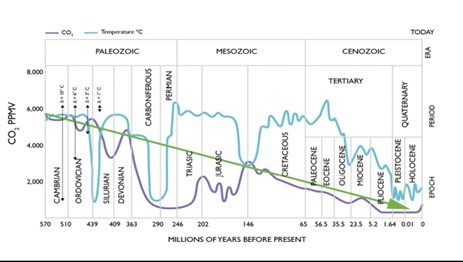
However, more importantly, this graph shows that over the last 570 million years there has been no link whatsoever between global temperature and CO2 levels. At the start of the Silurian period there was a marked dip in temperature, yet the CO2 level was not much less than it was at the beginning of the Cambrian. During the Carboniferous leading into the Permian both temperature and CO2 dipped before the temperature rebounded and remained high through the Mesozoic era apart from over the Jurassic/Cretaceous boundary while CO2 maintained its downward trend which continued into and through the Cenozoic era.
No-one can deny that the C02 proportion of the atmosphere has risen through the 19th to 21st centuries. What is in dispute is how much of that rise is natural and how much is due to the activities of mankind, if any. History records that in the Northern hemisphere there have been climate fluctuations. Over the last two thousand years we have had the Roman Warm Period, the Medieval Warm Period and the Little Ice Age to name just three. The little Ice age coincided with the Maunder and Dalton minimums of solar activity. Amsterdam’s canals froze and the Dutch became skaters while in London the River Thames froze in winter and ice fairs were held on it.
The Little Ice Age ended about 1850 which is, oddly, the same year which climate activist fasten on to in their assertions that rising CO2 leads to warming. Of course, CO2 will rise. As the climate warmed up the oceans had to release CO2 into the atmosphere. Water absorbs CO2 in inverse relationship to its temperature; the warmer the water, the less CO2 it can hold. We all know that from our observations of carbonated drinks be they sparkling soft drinks, beer or champagne.
We know too, from the evidence provided by Antarctic and Greenland ice-cores, that atmospheric CO2 rise LAGS a general temperature rises, it does not lead it. The amount of lag varies but it is generally thought to be in the range 600-800 years which would mean that the CO2 increase seen since the 1850s would be in response to the Medieval Warm Period (950 AD -1250 AD). This must mean that a proportion of the observed CO2 rise must be natural. While it is irrefutable that the industrial revolution and the resultant widespread use of coal, oil and gas has contributed CO2 to the atmosphere, the question must be how much of the increase is natural and how much is due to human activity.
The CO2 lag to temperature rise can be seen in the following graph taken from the data from the Vostok Antarctica ice cores. The blow up of the last 100,000 years leading into the current Holocene period will show it more clearly. Temperature is blue, CO2 purple:
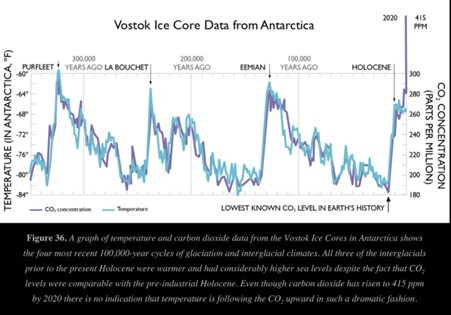
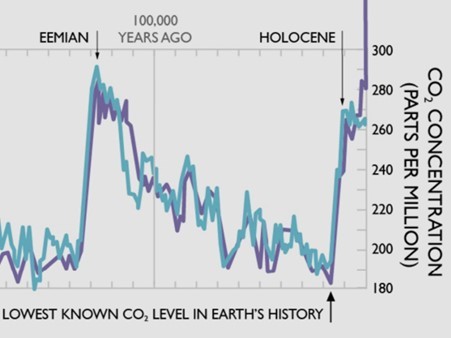
Also shown clearly is that while CO2 has risen steeply in recent times, temperature has not moved.
So where does the CO2 in the atmosphere get the heat from? Solar radiation of course, but not all of it. CO2 absorbs solar energy in the infra-red spectrum; it does so only in three specific frequency bands. Once all the solar energy in those frequency bands has been absorbed, that’s it. It doesn’t matter how much more CO2 is added to the atmosphere, the planet will not get one fraction of a degree warmer. We’re already at that stage. There is now more than enough CO2 in the atmosphere to absorb all the energy received from the sun in those three bands.
You might ask a climate activist what the level of CO2 should be. He or she will say that it was 280 ppm (0.028%) of the atmosphere prior to the industrial revolution so that is where it should be. However, as I have already shown in the graphs above CO2 level is not constant. It fluctuates and, overall, it has declined dramatically since the start of the Cambrian period 570 mya.
Whatever it is, what we do know is that 97% of the 0.0415% of the atmosphere which is CO2 is entirely natural. That means mankind is responsible for just 3% of it. The United Kingdom’s share of that 3% is just 1.2% of it. So that means the contribution of all the human activity in the UK to the global volume of atmospheric CO2 is 415 ppm (amount of CO2) x 0.03 x.0.012 = 0.1494 of a molecule of CO2 or approximately one six million seven hundred thousandth of the atmosphere. Just how much influence do we imagine one six million seven hundred thousandth of the atmosphere will have on the other six million, six hundred thousand, nine-hundred and ninety-nine parts. Absurd, isn’t it?
This absurdity can be shown with a simple analogy. Picture a golf course putting green. Imagine it covered with 1 million golf balls. Of those 1 million balls, 415 (0.0415%) represent atmospheric CO2. Of those 415 golf balls, 12.45 (3.0%) represent anthropogenic CO2. Of the 12.45 balls which represent anthropogenic CO2, 0.15 (to two decimal places) of a ball represents the United Kingdom’s contribution to atmospheric CO2. How much will the heat in that 0.15 of a ball affect the other 999,999.85 balls, do we imagine? Welcome to the madhouse.
This is why we are being told we will no longer be able to buy new petrol and diesel vehicles, why oil and gas boilers and wood-burning stoves will be banned and why we will be persuaded to eat insect protein. For the sake of one six million seven hundred thousandth of the atmosphere being reduced to zero. I think I’ll pass on that, if you don’t mind.
What the alarmists never point out is the beneficial nature of CO2. It is plant food. Plants absorb CO2 through stomata in their leaves and using photosynthesis break it down into carbon and oxygen. The carbon is used for plant growth and the oxygen, which we rather like, is given off. Horticulturalists know this so they pump CO2 into their green houses to help plant growth. In the following picture you can see the results of different amounts of CO2 administered to young spruce trees of the same age.
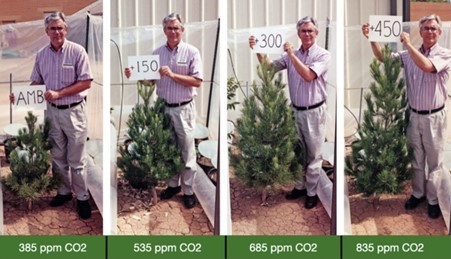
Imagine what increased CO2 would do for vegetation right across the planet. But you don’t need to imagine it, it’s happening. More atmospheric CO2 means a greener planet through more luxuriant vegetation where it already grows well and re-greening of desert areas where there has been little or no vegetation in recent times. It also means improved crop growth and therefore crop yields, so the world is better able to feed a growing population and do so while utilising less land. Here is an illustration of how the planet has greened between 1982 and 2010.

From all this it is obvious that the demonisation of CO2 and the widespread belief in a climate crisis caused by mankind’s production of it is one of the two great public policy blunders in recent history. The other is communism. We do not need to reduce CO2 output from human activity, we do not need to sequester atmospheric CO2 underground. Rather, we need even more of it in the atmosphere to continue the re-greening of the planet, to better feed the world’s under-nourished people. We also need to build an adequate CO2 buffer to protect human civilisation and our food supply to counter the virtually inevitable future glacial period which may suppress atmospheric CO2 in the way that glacial periods have done in the recent geological past.
No, I’m not interested in reducing my “carbon footprint” and nor should you be. On the contrary, I want to increase it as much as I possibly can.
H L Mencken, the American journalist, essayist, satirist and man of many quotes had this to say:
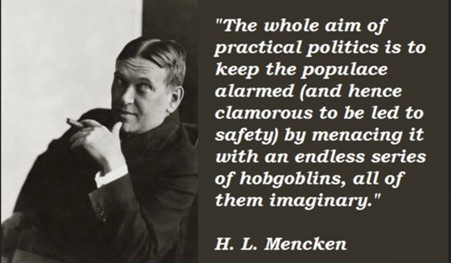
Climate change and the demonisation of carbon dioxide can thus be seen as a political construct which is being used by unscrupulous megalomaniacs to alarm, control and manipulate people for nefarious ends. It is the means through which we are all being herded towards an authoritarian One World Government of the United Nations and the World Economic Forum, a government which cannot be remotely democratic, a government which will attempt to enslave and control humanity for the benefit of the select few. We need to call ‘game over’.